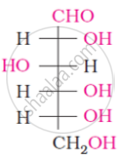Advertisements
Advertisements
प्रश्न
Draw the simple Fisher projection formulae of D - (+) - glucose and D - (-) - fructose
उत्तर


APPEARS IN
संबंधित प्रश्न
Write the reaction that indicates the presence of -CHO group in glucose
How many moles of acetic anhydride will be required to form glucose pentaacetate from 2M of glucose?
(a) 2
(b) 5
(c) 10
(d) 2.5
Glucose on reaction with HI gives n-hexane. What does it suggest about the structure of glucose?
Fill in the blanks by choosing the appropriate word/words from those given in the brackets:
(iodoform, acetaldehyde, positive, greater, acidic, acetone, disaccharide, negative, increases, glucose, decreases, chloroform, polysaccharide, lactose, lesser, basic, cationic hydrolysis, anionic hydrolysis)
Sucrose is a _________ and yields upon hydrolysis, a mixture of ________ and fructose.
What do you observe when glucose is treated with bromine water?
Answer the following question.
What is the basic structural difference between glucose and fructose?
Write the reactions involved when D-glucose is treated with the following reagent:
Br2 water
Write the reactions involved when D-glucose is treated with the following reagent:
H2N-OH
The following compound can be called as:

The spatial arrangement of the given molecule is denoted by:

Which of the following statements is incorrect regarding glucose?
The symbols D and L represents ____________.
When glucose reacts with bromine water, the main product is ____________.
Which of the following properties of glucose cannot be explained by its open chain structure?
(i) Glucose does not form hydrogen sulphite with NaHSO3.
(ii) On oxidation with HNO3 glucose gives saccharic acid.
(iii) Glucose is found to exist in two different crystalline forms which are named as α and β.
Glucose is found to exist in two different α and β crystalline forms. These forms can be obtained by:
(i) The α form of glucose is obtained by crystallisation from a concentrated solution of glucose at 303 K.
(ii) The β form of glucose is obtained by crystallisation from a concentrated solution of glucose at 303 K.
(iii) The β form is obtained by crystallisation from hot and saturated aqueous solution at 371 K.
(iv) The α form is obtained by crystallisation from hot and saturated aqueous solution at 371 K.
A solution of D-glucose in water rotates the plane polarised light ____________.
The number of chiral carbon atoms present in cyclic structure α-D(+) glucose:
The two forms of D-glucopyranose obtained from the solution of D-glucose are called ____________.
Which of the following pairs represents anomers?
How will you distinguish 1° and 2° hydroxyl groups present in glucose? Explain with reactions.
Assertion: D (+) – Glucose is dextrorotatory in nature.
Reason: ‘D’ represents its dextrorotatory nature.
When D-glucose reacts with HI, it forms ______.
Give the reaction of glucose with hydrogen cyanide. Presence of which group is confirmed by this reaction?
Give a reason for the following observations:
Penta-acetate of glucose does not react with hydroxylamine.
